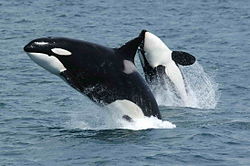
Back Walvisagtiges Afrikaans Wale ALS የዓሣንበሪ አስተኔ Amharic Cetacea AN حوتيات Arabic حيتانيات ARZ তিমি Assamese Cetacea AST Megoldunol (Cetacea) AVK Cetacea Azerbaijani
| Cetacea Temporal range: Early Eocene – Present
| |
|---|---|
| Scientific classification | |
| Domain: | Eukaryota |
| Kingdom: | Animalia |
| Phylum: | Chordata |
| Class: | Mammalia |
| Order: | Artiodactyla |
| Suborder: | Whippomorpha |
| Clade: | Cetaceamorpha |
| Infraorder: | Cetacea Brisson, 1762 |
| Subgroups | |
(see text for families) | |
| Diversity | |
| Around 94 species | |
Cetacea (/sɪˈteɪʃə/; from Latin cetus 'whale', from Ancient Greek κῆτος (kêtos) 'huge fish, sea monster')[3] is an infraorder of aquatic mammals belonging to the order Artiodactyla that includes whales, dolphins and porpoises. Key characteristics are their fully aquatic lifestyle, streamlined body shape, often large size and exclusively carnivorous diet. They propel themselves through the water with powerful up-and-down movements of their tail, which ends in a paddle-like fluke, using their flipper-shaped forelimbs to steer.[4]
While the majority of cetaceans live in marine environments, a small number reside solely in brackish or fresh water. Having a cosmopolitan distribution, they can be found in some rivers and all of Earth's oceans, and many species migrate throughout vast ranges with the changing of the seasons.
Cetaceans are famous for their high intelligence, complex social behaviour, and the enormous size of some of the group's members. For example, the blue whale reaches a maximum confirmed length of 29.9 meters (98 feet) and a weight of 173 tonnes (190 short tons), making it the largest animal ever known to have existed.[5][6][7]
There are approximately 90 living species split into two parvorders: the Odontoceti or toothed whales, which contains 75 species including porpoises, dolphins, other predatory whales like the beluga and sperm whale, and the beaked whales and the filter feeding Mysticeti or baleen whales, which contains 15 species and includes the blue whale, the humpback whale and the bowhead whale, among others. Despite their highly modified bodies and carnivorous lifestyle, genetic and fossil evidence places cetaceans within the even-toed ungulates, most closely related to hippopotamus.
Cetaceans have been extensively hunted for their meat, blubber and oil by commercial operations. Although the International Whaling Commission has agreed on putting a halt to commercial whaling, whale hunting is still ongoing, either under IWC quotas to assist the subsistence of Arctic native peoples or in the name of scientific research, although a large spectrum of non-lethal methods are now available to study marine mammals in the wild.[8] Cetaceans also face severe environmental hazards from underwater noise pollution, entanglement in ropes and nets, ship strikes, build-up of plastics and heavy metals, and anthropogenic climate change,[9][10] but how much they are affected varies widely from species to species, from minimally in the case of the southern bottlenose whale to the baiji (Chinese river dolphin) which is considered to be functionally extinct due to human activity.[11]
- ^ Uhen, M.D. (2008). "New protocetid whales from Alabama and Mississippi, and a new Cetacean clade, Pelagiceti". Journal of Vertebrate Paleontology. 28 (3): 589–593. doi:10.1671/0272-4634(2008)28[589:NPWFAA]2.0.CO;2. JSTOR 20490986. S2CID 86326007.
- ^ Fordyce, E.; de Muizon, C. (2001). "Evolutionary history of the cetaceans: a review". In Mazin, J.-M.; de Buffrénil, V. (eds.). Secondary Adaptations of Tetrapods to Life in the Water: Proceedings of the international meeting, Poitiers, 1996. München, Germany: Verlag Dr. Friedrich Pfeil. pp. 169–233. ISBN 3-931516-88-1. LCCN 2002550356. OCLC 52121251. OL 20591860M.
- ^ M. Raneft, D.; Eaker, H.; W. Davis, R. (2001). "A guide to the pronunciation and meaning of cetacean taxonomic names" (PDF). Aquatic Mammals. 27 (2): 185. Archived (PDF) from the original on 2016-03-27.
- ^ E. Fish, Frank (2002). "Balancing Requirements for Stability and Maneuverability in Cetaceans". Integrative and Comparative Biology. 42 (1): 85–93. doi:10.1093/icb/42.1.85. PMID 21708697. S2CID 25036870.
- ^ Wood, Gerald The Guinness Book of Animal Facts and Feats (1983) ISBN 978-0-85112-235-9
- ^ Davies, Ella (2016-04-20). "The longest animal alive may be one you never thought of". BBC Earth. Retrieved 2018-02-14.
- ^ "Largest mammal". Guinness World Records.
- ^ Notarbartolo di Sciara, G.; Briand, F. (2004). "Investigating the Roles of Cetaceans in Marine Ecosystems - An overview". CIESM Workshop Monographs. 25: 1–15.[1]
- ^ Cara E. Miller (2007). Current State of Knowledge of Cetacean Threats, Diversity, and Habitats in the Pacific Islands Region (PDF). Whale and Dolphin Conservation Society. ISBN 978-0-646-47224-9. Archived from the original (PDF) on 8 September 2015. Retrieved 5 September 2015.
- ^ Nowacek, Douglas; Donovan, Greg; Gailey, Glenn; Racca, Roberto; Reeves, Randall; Vedenev, Alexander; Weller, David; Southall, Brandon (2013). "Responsible Practices for Minimizing and Monitoring Environmental Impacts of Marine Seismic Surveys with an Emphasis on Marine Mammal". Aquatic Mammals. 39 (4): 356–377. Bibcode:2013AqMam..39..356N. doi:10.1578/am.39.4.2013.356.
- ^ Lovgren, Stefan (December 14, 2006). "China's Rare River Dolphin Now Extinct, Experts Announce". National Geographic News. Washington, D.C.: National Geographic Society. Archived from the original on December 18, 2006. Retrieved 2015-10-18.





